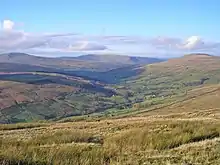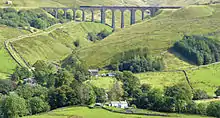Dentdale
Dentdale is a dale or valley in the north-west of the Yorkshire Dales National Park in Cumbria (historically in Yorkshire), England.[1] The dale is the valley of the River Dee, but takes its name from the village of Dent. The dale runs east to west starting at Dent Head which is the location of a railway viaduct on the Settle-Carlisle Line.[2]

Dentdale is one of the few of the Yorkshire Dales that drain westwards towards the Irish Sea.[3]
History
Dentdale was first settled in the 10th century when Norse invaders first entered the dale.[4] The dale was also known to the Romans although there is no evidence of settlement during that period. The dale was one of the last of the Yorkshire Dales to be Enclosed in 1859.[5]
The typical occupations in the dale were farming and worsted related. Several mills used the fast flowing waters of the River Dee to supply power to the mills.[6] At least one of these was converted to the Dent Marble industry by 1810. [7] Whilst fishing on the Dee at Dentdale in the 1840s, William Armstrong saw a waterwheel in action, supplying power to a marble quarry. It struck Armstrong that much of the available power was being wasted and it inspired him to design a successful hydraulic engine which began the accumulation of his wealth and industrial empire.
Dentdale was originally in the Ewecross wapentake of the West Riding of Yorkshire, but was transferred to Cumbria in 1974.[8]
Settlements
Dent village is the main shopping and social centre of the dale. There are two other major villages; Dent Head and Gawthrop.[9] Additionally there are two hamlets at the top of the dale - Cowgill (where Dent Station is located) and Stone House.[10] It has been noted that it is increasingly difficult for young people and family groups to stay in the dale as housing becomes more unaffordable.[11]
There are over 200 listed buildings and structures in Dentdale which include the railway viaducts, bridges, barns, farmhouse, mileposts and even telephone boxes.[12] Only one structure is Grade I listed, that of the Church of St Andrew in Dent.[13]
Transport

The famous Settle-Carlisle Line[14] passes across the eastern edge of the dale being carried over the becks that feed the River Dee on Dent Head Viaduct[15] and over Artengill Beck on Arten Gill Viaduct.[16][note 1]
The walking route of the Dales Way crosses through the dale in a rough east/west axis.[17] The route and the seclusion of the dale make it popular with walkers and lovers of The Dales.[18]
National Cycle route 68 (also known as the Pennine Cycleway) that runs from Derbyshire to Berwick-upon-Tweed passes through the dale.[19]
The C5101 road runs through the dale from the nearest main road at Sedbergh (the A683 and A684) to Newby Head Moss, east of the dale head, where it meets the B6255 Hawes to Ingleton road.
Western Dales Bus operate a year round Saturday and summer Sunday service between Dent station and Sedbergh with stops en route.[20]
Geology
The Dent Fault cuts across the valley close to the village of Gawthrop, marking a geological boundary between the Carboniferous Limestone of Deepdale and the Craven Dales to the south and the older Silurian and Ordovician rocks of the Howgill Fells to the north.[21]
The Upper Dentdale Cave System, which is 2 miles (3.2 km) east of Dent, was recognized as a site of Special Scientific Interest (SSSI) in 1998.[22] The cave system extends for 1 mile (1.6 km) beneath the valley floor under the River Dee and is notable for providing a unique insight into how caves are formed in valley floors.[23]
Dent Marble was quarried and polished in Dentdale between 1760 and 1909.[24] Both the viaducts that carry the Settle-Carlisle line over the dale are constructed from Dent Marble.[25] The opening of the railway afforded the opportunity to export the marble out of the dale for the first time. The stone is not actually marble, it is a highly polished form of Black Limestone.[26]
Notes
- Arten Gill Viaduct is the spelling from the railway even though the water below is Artengill.
References
- "Yorkshire Dales Walk - Dentdale". Yorkshire Life. Retrieved 5 January 2016.
- "Dent Head". www.yorkshire-dales.com. Retrieved 5 January 2016.
- "The Cumbrian Dales" (PDF). Yorkshire Dales. p. 1. Retrieved 5 January 2016.
- "Dentdale - Visit Cumbria". Visit Cumbria. Retrieved 5 January 2016.
- "Dent and Dentdale". Yorkshire Dales trail. Retrieved 5 January 2016.
- "Cowgill, a Geologist and the River Dee-Walks-The AA". www.theaa.com. Retrieved 5 January 2016.
- "Out of Oblivion: A landscape through time". www.outofoblivion.org.uk. Retrieved 5 January 2016.
- "Dent Cumbria County History Trust". www.cumbriacountyhistory.org.uk. Retrieved 5 January 2016.
- "Dentdale". www.yorkshire-dales.com. Retrieved 5 January 2016.
- "Dentdale". Yorkshire Dales National Park Authority. Retrieved 5 January 2016.
- "DENT CONSERVATION AREA APPRAISAL" (PDF). Yorkshire Dales. December 2009. p. 21. Retrieved 5 January 2016.
- "Listed Buildings in Dent, Cumbria, England". www.britishlistedbuildings.co.uk. Retrieved 5 January 2016.
- "Church of St Andrew - Dent - Cumbria - England". www.britishlistedbuildings.co.uk. Retrieved 5 January 2016.
- "The Settle - Carlisle Line". www.sandctrust.org.uk. Retrieved 5 January 2016.
- Greenbank, Tony (9 May 2011). "Country diary: Dentdale, Yorkshire Dales". The Guardian. Retrieved 5 January 2016.
- "Heritage Locations". www.transportheritage.com. Retrieved 5 January 2016.
- "The Route". www.dalesway.org. Retrieved 5 January 2016.
- "DENT, DEEPDALE & THE DEE WALK seclusion of Dentdale". On: Yorkshire Magazine. Retrieved 5 January 2016.
- "Yorkshire Dales National Park - All routes". www.cyclethedales.org.uk. Retrieved 5 January 2016.
- "Dentdale and Howgills". www.walkingintheyorkshiredales.co.uk. Retrieved 5 January 2016.
- "Dentdale". www.yorkshiredales.co.uk. Archived from the original on 4 March 2016. Retrieved 5 January 2016.
- "Recognition for caves". The Westmorland Gazette. Retrieved 5 January 2016.
- "Upper Dentdale Cave" (PDF). sssi - natural england. pp. 1–2. Retrieved 5 January 2016.
- "The Dentdale Marble Industry". www.cumbria-industries.org.uk. 20 April 2014. Retrieved 5 January 2016.
- "Engineering Timelines - Arten Gill Viaduct". www.engineering-timelines.com. Retrieved 5 January 2016.
- "History of Yorkshire". www.museumsintheyorkshiredales.co.uk. Retrieved 5 January 2016.